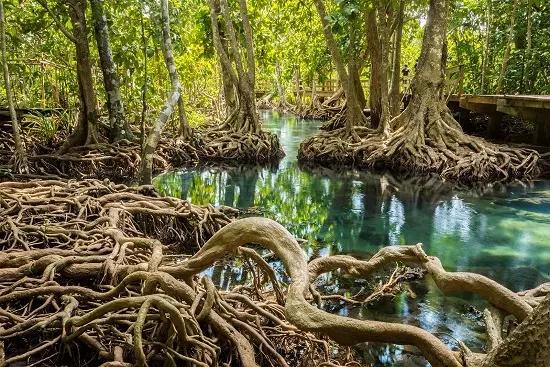Last Updated: 31-12-2021 | Esoma-KE
Importance of Gaseous Exchange in Living Organisms
- Living organisms require energy to perform cellular activities.- The energy comes from breakdown of food in respiration.
- Carbon (IV) oxide is a by product of respiration and its accumulation in cells is harmful which has to be removed.
- Most organisms use oxygen for respiration which is obtained from the environment.
- Photosynthetic cells of green plants use carbon (Iv) oxide as a raw material for photosynthesis and produce oxygen as a byproduct.
- The movement of these gases between the cells of organisms and the environment comprises gaseous exchange.
- The process of moving oxygen into the body and carbon (Iv) oxide out of the body is called breathing or ventilation.
- Gaseous exchange involves the passage of oxygen and carbon (IV) oxide through a respiratory surface.
- Diffusion is the main process involved in gaseous exchange.
Gaseous Exchange in Plants
- Oxygen is required by plants for the production of energy for cellular activities.- Carbon (IV) oxide is required as a raw material for the synthesis of complex organic substances.
- Oxygen and carbon (IV) oxide are obtained from the atmosphere in the case of terrestrial plants and from the surrounding water in the case of aquatic plants.
- Gaseous exchange takes place mainly through the stomata.
Structure of Guard Cells
- The stoma (stomata - plural) is surrounded by a pair of guard cells.- The structure of the guard cells is such that changes in turgor inside the cell cause changes in their shape.
- They are joined at the ends and the cell walls facing the pore (inner walls) are thicker and less elastic than the cell walls farther from the pore (outer wall).
- Guard cells control the opening and closing of stomata.
Mechanism of Opening and Closing of Stomata
- In general stomata open during daytime (in light) and close during the night (darkness).- Stomata open when osmotic pressure in guard cells becomes higher than that in surrounding cells due to increase in solute concentration inside guard cells. Water is then drawn into guard cells by osmosis.
- Guard cells become turgid and extend.
- The thinner outer walls extend more than the thicker walls.
- This causes a bulge and stoma opens.
- Stomata close when the solute concentration inside guard cells become lower than that of surrounding epidermal cells.
- The water moves out by osmosis, and the guard cells shrink i.e. lose their turgidity and stoma closes.
Proposed causes of turgor changes in guard cells
Accumulation of sugar
- Guard cells have chloroplasts while other epidermal cells do not.- Photosynthesis takes place during daytime and sugar produced raises the solute concentration of guard cells.
- Water is drawn into guard cells by osmosis from surrounding cells.
- Guard cells become turgid and stoma opens.
- At night no photosynthesis occurs hence no sugar is produced.
- The solute concentration of guard cells falls and water moves out of the guard cells by osmosis.
- Guard cells lose turgidity and the stoma closes.
pH changes in guard cells occur due to photosynthesis
- In day time carbon (IV) oxide is used for photosynthesis. This reduces acidity while the oxygen produced increases alkalinity.- Alkaline pH favours conversion of starch to sugar.
- Solute concentration increases inside guard cells, water is drawn into the cells by osmosis. Guard cells become turgid and the stoma opens.
- At night when no photosynthesis, Respiration produces carbon (IV) oxide which raises acidity .This favours conversion of sugar to starch. low sugar concentration lead to loss of turgidity in guard cells and stoma closes.
Explanation is based on accumulation of potassium ions
- In day time (light) adenosine triphosphate (ATP) is produced which causes potassium ions to move into guard cells by active transport.- These ions cause an increase in solute concentration in guard cells that has been shown to cause movement of water into guard cells by osmosis.
- Guard cells become turgid and the stoma opens.
- At night potassium and chloride ions move out of the guard cells by diffusion and level of organic acid also decreases.
- This causes a drop in solute concentration that leads to movement of water out of guard cells by osmosis.
- Guard cells lose turgor and the stoma closes.
Process of Gaseous Exchange in Root Stem and Leaves of Aquatic and Terrestrial Plants
Gaseous Exchange in leaves of Terrestrial Plants
- Gaseous exchange takes place by diffusion.- The structure of the leaf is adapted for gaseous exchange by having intercellular spaces that are filled.
- These are many and large in the spongy mesophyll.
- When stomata are open,carbon(IV)oxide from the atmosphere diffuses into the substomatal air chambers.
- From here, it moves into the intercellular space in the spongy mesophyll layer.
- The CO2 goes into solution when it comes into contact with the cell surface and diffuses into the cytoplasm.
- A concentration gradient is maintained between the cytoplasm of the cells and the intercellular spaces.
- CO2 therefore continues to diffuse into the cells.
- The oxygen produced during photosynthesis moves out of the cells and into the intercellular spaces.
- From here it moves to the substomatal air chambers and eventually diffuses out of the leaf through the stomata.
- At night oxygen enters the cells while CO2 moves out.
Gaseous exchange in the leaves of aquatic (floating)plants
- Aquatic plants such as water lily have stomata only on the upper leaf surface.- The intercellular spaces in the leaf mesophyll are large.
- Gaseous exchange occurs by diffusion just as in terrestrial plants.
Observation of internal structure of leaves of aquatic plants
- Transverse section of leaves of an aquatic plant such as Nymphaea differs from that of terrestrial plant.
The following are some of the features that can be observed in the leave of an aquatic plant;
- Absence of cuticle.
- Palisade mesophyll cells are very close to each other ie.compact.
- Air spaces (aerenchyma) in spongy mesophyll are very large.
- Sclereids (stone cells) are scattered in leaf surface and project into air spaces.
- They strengthen the leaf making it firm and assist it to float.
Gaseous Exchange Through Stems
Terrestrial Plants
- Stems of woody plants have narrow openings or slits at intervals called lenticels.- They are surrounded by loosely arranged cells where the bark is broken.
- They have many large air intercellular spaces through which gaseous exchange occurs.
- Oxygen enters the cells by diffusion while carbon (IV) oxide leaves.
- Unlike the rest of the bark, lenticels are permeable to gases and water.
Aquatic Plant Stems
- The water lily, Salvia and Wolfia whose stems remain in water are permeable to air and water.- Oxygen dissolved in the water diffuses through the stem into the cells and carbon (IV) oxide diffuses out into the water.
Gaseous Exchange in Roots
Terrestrial Plants
- Gaseous exchange occurs in the root hair of young terrestrial plants.- Oxygen in the air spaces in the soil dissolves in the film of moisture surrounding soil particles and diffuses into the root hair along a concentration gradient.
- It diffuses from root hair cells into the cortex where it is used for respiration.
- Carbon (IV) oxide diffuses in the opposite direction.
- In older roots of woody plants, gaseous exchange takes place through lenticels.
Aquatic Plants
- Roots of aquatic plants e.g. water lily are permeable to water and gases.- Oxygen from the water diffuses into roots along a concentration gradient.
- Carbon (IV) oxide diffuses out of the roots and into the water.
- The roots have many small lateral branches to increase the surface area for gaseous exchange.
- They have air spaces that help the plants to float.
- Mangrove plants grow in permanently waterlogged soils, muddy beaches and at estuaries.
- They have roots that project above the ground level.
- These are known as breathing roots or pneumatophores.
- These have pores through which gaseous exchange takes place e.g. in Avicenia the tips of the roots have pores.
- Others have respiratory roots with large air spaces.

Mangrove Trees - Picture Courtesy of Britannica

